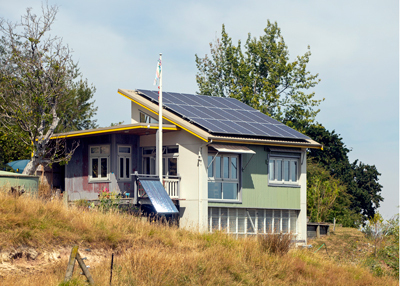
Home Profile: the good life
Architect Lindsay Wood found Nelson was the perfect place to create a self-sufficient, sustainable lifestyle.
When you live in the region with a reputation of having one of the sunniest climates in the country, it makes sense to harness that potential.
Eco architect and climate change strategist Lindsay Wood was keen to do just that when he designed his house at Nelson’s Braemar Eco Village, just two kilometres from the city’s centre. The 40sqm of photovoltaic panels on his roof produce enough power to not only charge his electric van and largely run his one-bedroom home but, since he produces four times more than he consumes, the excess goes out to the grid to help power others’ residences, too.
What’s more, the rain collection system from his roof means he’s almost entirely self-sufficient with water, with the occasional top up for garden watering from the neighbouring tank he shares with the village’s 30 or so other inhabitants.
With a highly effective composting toilet – that surprises visitors with its odour-free operation – he’s even self-sufficient in that department too. Once every couple of years the composted solids in the chamber below the floor require emptying by Lindsay, who buries them around his 40 fruit and nut trees. The liquids produced by the system are collected in a separate vessel, diluted and dispersed in the same way.
“Recommended practise is to use it to fertilise trees and not put it on the veggie patch,” says Lindsay, who moved into the 60sqm property in July 2014 after 18 months in the design and build phase. “The basic rule with a composting toilet is that it goes through three stages: composting at site; then through the ground; then through a tree. That way, if there was a risk of pathogens, which would be doubtful, it would be eliminated.”
Lindsay, who speaks publicly and runs workshops on climate response, vowed to himself he would commit as much of his usable 1200sqm block as possible for productive food growing. Despite a self-confessed lack of green fingers or time to dedicate to his veggie patch, he’s still 60-70% self-sufficient in fresh produce. Corn, herbs, beetroot, and cherry tomatoes all grow well, and the blueberries, blackberries and grapes are all fair game for his visiting grandchildren.
“I grow about five times more than I can eat so I give food away and I’ve got pickles coming out of my ears,” he says with a laugh. “I didn’t want big flower beds and lawns. I think people can get too precious about how things look. We should accept that having things maybe not exactly as we like them visually is okay if there are other gains.”
More veggies are grown in Braemar’s communal garden and tunnel house, and there are also eggs from the shared chooks.

His aim for his home is for it to be a test bed for the environmental performance schemes he’s always dreamt of trying. As well as designing the building for maximum thermal balance, he used a large amount of recycled materials to create it. The corrugated iron cladding he rescued after it had been removed from the leaking roof of the village’s communal hall. “The council said I could use it if I could get verification from the manufacturer that it would be worthy. But it was made in Australia 100 years ago, so I had to seek other expert help on that front to verify its durability.” To prepare it for its rebirth,
Lindsay water-blasted off the paint before priming in a five-stage process – a time consuming business he performed while living on site in his campervan – which he now runs successfully on 100% biodiesel. “Some of the panels were just unusable but I ended up with enough to clad the walls where I wanted it,” he says. “I’d be back and forth to Resene for test pots to try and match the metal as closely as I could. They’d joke each time ‘Here comes the guy for his fifty shades of grey!’”
Other recycled materials he salvaged to help create his bright, cosy and surprisingly modern home include the underfloor polystyrene insulation which came from a demolished coolstore, a wall of green corrugated iron removed from another reroofed building in the village, the entire kitchen cabinetry and benchtop and the internal doors. Insulation in the walls is recycled wool purchased from a then local company, and even the deck was created from the scaffold planks used by the builders during the construction phase.
“I urge anyone who believes it’s too hard to make lifestyle changes in the face of the risks from climate change to re-evaluate,” Lindsay adds. “Instead of thinking about the costs of doing it, we need to consider the incredible costs of not doing it. Of course sustainability is not the same as self-sufficiency – but they’re aligned and will help build a durable society. I want to do whatever I can to live a sustainable lifestyle and reduce my carbon footprint – being more self-sufficient is an important contribution to that.
“I’m pleased that I’m giving things a go; I’m trying to walk the talk. There are some things I’d like to have done better or had more time to try but that’s the nature of an experimental building and I’m happy to be part of helping society move in a direction that I think is important.”
Reported by Fiona Terry for our AA Directions Autumn 2020 issue
